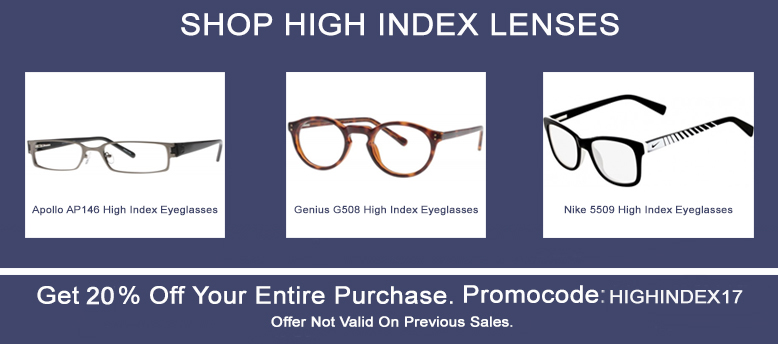How to Get a Pair of High-Index Eyeglasses
High index lenses have been around for a fairly long time, but in many places people are only just now beginning to hear about and ask for them. If you are one of the many members of the glasses wearing population, you may have recently heard about the potential of high index lenses for reducing thickness and increasing clarity compared to standard lenses. There are a lot of people currently considering the potential benefits of choosing high index lenses for their next pair of eyeglasses so you are definitely not alone. Unlike contacts, there are very few downsides to the high index switch and when you’re sure about what you want, the only questions left are where to get them and which high index material is right for you.
Being stuck behind thick panes of glass or plastic is no fun for anyone, and the higher your prescription is, the thicker they get. This not only creates unattractive thick edges where the lens meets the frames, it also makes your eyes harder to see through the material and can magnify your eyes in a disconcerting and stereotypical way. Most people with bad eyes who choose not to or cannot wear contacts have wished for thinner lenses, often unaware that there has been an increasing number of high index options available over the years. For decades, the optical community has been innovating new materials that bend light more efficiently than standard glass or plastic lenses.
A normal lens index, the kind you get without asking any special questions during the glasses acquisition process, is about 1.51 and each index category higher than that also comes with a correspondingly thinner result and a slight increase in weight. The next step up is Trivex at 1.54 which has been designed to be the lightest lens material available. Next comes Polycarbonate at 1.58, designed for it’s indestructible impact resistance and UV protection. From there we reach the truly high index with incredibly specialized plastic formulas in two major categories, the 1.60-1.67 range and the 1.70-1.74 range.
Getting Your Prescription
When investing in new lens technology, it’s important to have the most recent information on your vision needs so you’ll want to visit your optometrist or ophthalmologist. You’re probably already reasonably familiar with the appointment making process, even if you’ve recently moved and had to change doctors offices. An appointment that results in high index lenses is just like any other.
You start with pupil dilation, either chemically or naturally by sitting in a dark room for a little while. Then the optometrist swings over the somewhat hellish-looking hanging masquerade gear and begins the ‘better one, better two’ routine until you and they have reached a few conclusions. You’ll practice on the eye chart, the reading distance test, and may even wander off for ‘puff test’ where the doctor blows air into your eye to test its internal pressure.
Finally, at the end of this process, your optometrist will be ready to write you a prescription and thank you for coming. Some doctors give you the little square-ish piece of paper as you leave their inner sanctum while  others give it to you as you’re ensuring the appointment has been paid for at the reception desk. On the prescription itself are a collection of numbers that are very important as to whether or not you want high index lenses, and which material you should ask for.
others give it to you as you’re ensuring the appointment has been paid for at the reception desk. On the prescription itself are a collection of numbers that are very important as to whether or not you want high index lenses, and which material you should ask for.
The most important number is the “Sphere” column, which indicates the strength of correction you’ll need from a lens. Positive numbers indicate farsightedness while negative numbers are for the nearsighted majority. In case you’re curious, OD and OS stand for “oculus dexter” and “oculus sinister” meaning the right and left eyes respectively. “Add” mostly has to do with magnification for bifocals, while Cylinder and Axis work together to fix astigmatisms. Prism and Base are another pair which can accommodate people with slightly uneven eyes without needing lop-sided glasses.
That said, if your Sphere numbers are greater than +/-2.0, you can benefit from high index lenses. Any lower than that and the lenses will become ‘too thin’ and no longer live up to the impact resistant requirements of eyeglass lenses in the US.
Ordering from Your Optometrist
Where you get your new high index eyeglasses determines a lot about the options available to you, especially in terms of frames. Remember that you can pick any frame you want, even delicate metal or rimless frames because the new lenses will be much thinner and therefore more attractive in thin-line frames. This is your opportunity to reinvent yourself, no longer shackled by the limitations of thick lenses. For this reason, you may want to go all-out trying on frames and considering designing a whole new look.
Most, but not all, optometrist or ophthalmologist offices have a small optical shop attached which speeds up the process of turning a prescription into a pair of new glasses. If you’re in a hurry to finish the process or like their selection of frames, this is a perfectly nice way to order your new high index eyeglasses but you don’t have to buy frames where you get your prescription and the office won’t mind if you take your prescription elsewhere. In general, these shops tend to be smaller in both size and selection from venues that primarily specialize in selling frames and getting people fitted into their new glasses.
Going to an Optical Shop
For a much wider selection of lenses and a greater supply of opticians to help you choose, you can take your shopping to an official optical shop which resembles an optometrist’s office but functions primarily to fit new eye-wear to the visually impaired. Most optical shops, for instance, have a contacts trying room somewhere in the back. Here is your opportunity to spend the better part of an hour trying on frames and imaging what you might look like with much thinner lenses. With those thick lens-edges no longer able to bring you down, you could have any pair in the shop you want to wear every day and care to pay for. While the lenses may no longer be obscuring the view of your eyes, your frames will still become an extension of your personality and semi-permanent appearance.
When you’ve found a pair you want, give your optician a copy of your prescription and make sure to let them know that you want high index lenses. If you’ve done your research and know exactly what you want, they’ll be more than happy to oblige. If, on the other hand, you simply know that thinner is better, your optician will be able to look at the prescription and help you choose an index and lens material that will work best for your optical and appearance needs.
Whether you’re an avid online shopper or just really choosy about the style of your frames, the online solution may be the best place to find the perfect eyeglasses for high index lenses. There are a reasonable number of online stores that sell not only frames, but high index lenses to go with them. To get these glasses, it’s important that you have a personally retained copy of your prescription so you can punch it into the order form. Don’t forget the cylinder, axis, prism, and base if these are noted on your prescription. After choosing a pair of frames you love and requesting high index lenses set neatly inside them, all you have to do is wait for production and delivery times.
Congratulations! Whether you bought a conveniently stylish pair straight out of the optometrist’s office or spent months combing over online reviews, you can now be the proud owner of a new pair of sleek, attractive, and incredibly convenient high index eyeglasses.



Leave a Reply
You must be logged in to post a comment.